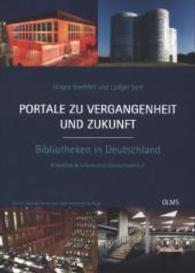- ホーム
- > 洋書
- > ドイツ書
- > Humanities, Arts & Music
- > History
- > antiquity
Description
(Text)
(Text)
The contributions of this volume study economic aspects of Roman burial architectures for extended numbers of burials, such as columbaria, large hypogea, or catacombs, and try to form a picture of their owners and users. They discuss how far economic reasons played a leading role in the invention, the development and the use of these big burial monuments in Rome and how these buildings fulfilled the religious and social needs of their users, especially in the transitional period from the Roman to the Early Christian period. New studies in Roman funeral monuments could document interesting evidence for the dynamic process of the preparation and use of burial space. Especially in larger architectures for much more than a single family, the economic aspects of the ownership and use of these installations is fascinating. Who were the planners of the projects, why were certain places and specific architectures chosen? How and at what time in the project were the burials of the owners and their families provided for? In what manner were further tombs sold or given to others? And which locations within the installation were they able to get? During the last decades, a series of general studies on Roman burials and burial customs were base on older documentation out of necessity, while new and more detailed analysis of single monuments often provide new and different insights of interpretation."







